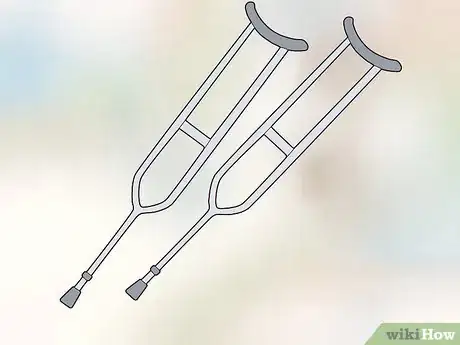This article was medically reviewed by Mayami Oyanagi. Mayami Oyanagi is a Physical Therapist and the owner of PT STOP Physical Therapy & Wellness, an individualized physical therapy practice in Los Angeles, California. With over 14 years of experience, Mayami specializes in orthopedic injuries, manual therapy, and sports medicine. She holds an MS in Physical Therapy from the University of Hartford. Mayami is also a board certified Orthopedic Clinical Specialist. She treats the root cause of her client’s problems by utilizing biomechanical assessments.
wikiHow marks an article as reader-approved once it receives enough positive feedback. In this case, 100% of readers who voted found the article helpful, earning it our reader-approved status.
This article has been viewed 249,158 times.
Researchers say that it's important to start walking as soon as possible after an injury or surgery, but it's important for your affected leg to be supported.[1] Fortunately, experts agree that crutches can help you walk without putting weight on your leg. It's important to use your crutches correctly so you don't accidentally fall, worsen your leg injury, or damage the skin or tissue under your arms.[2] With a little practice, you can learn to walk with your crutches.
Steps
Fitting and Positioning
-
1Obtain new crutches or used ones that are in very good condition. Make sure the crutches are sturdy, and that the rubber padding, where your armpit rests, is still springy. Inspect the bolts or pins that adjust the crutch length. Make sure the crutches have the rubber tips at the bottom.[3]
-
2Adjust the crutches to a comfortable height. Stand up straight and place your palms on the hand grips. When adjusted to the correct position, the top of the crutches should reach between 1.5 to 2 in (3.8 to 5.1 cm) below your armpits.[4] The hand grips should be even with the top of your hip line.[5]
- When the crutches are properly adjusted, your arms should be comfortably bent while you stand up straight.
- When you adjust the crutches, wear the shoes you'll be most frequently wearing when you use the crutches. They should have low heels and good support.
Advertisement -
3Hold the crutches correctly. The crutches should be held tightly to your side for maximum control. The cushions at the tops of the crutches should not actually touch your armpits; rather, your hands should absorb the weight of your body as you start to use the crutches.[6]
Walking and Sitting
-
1Use the crutches to help you walk. Lean forward and place both crutches about a foot in front of your body. Move as though you are taking a step with your injured foot, but place your weight instead on the handgrips of the crutches. Swing your body forward and rest your non-injured foot on the ground. Repeat to continue moving forward.[7]
- Hold your injured foot cocked slightly behind your body, several inches from the floor so that it does not drag.
- Practice walking this way with your head forward, rather than looking at your feet. The motion will begin to feel more natural with practice.
- Practice walking backward, too. Look behind you to make sure no furniture or other items are in your way.
-
2Use the crutches to help you sit. Locate a sturdy chair that won't slide backward when you sit down. Back up to it and put both crutches in one hand, leaning on them slightly and placing your injured foot in front of you. Use the other hand to steady yourself against the chair and lower yourself into the seat.[8]
- Lean the crutches against the wall or a sturdy table with the armpit rests down. They may topple over if you lean them tip-down.
- When you're ready to stand up, turn the crutches right side up and hold them in the hand on your non-injured side. Hoist yourself up and place your weight on your healthy foot, then pass one crutch to the injured side and balance using the hand grips.
Taking the Stairs
-
1Lead with your good foot when you go up stairs. Face the stairs and hold the handrail with one hand. Tuck the crutches beneath your armpit on the other side. Step up with your good foot and keep your injured foot behind you. Lean on the crutches as you take the next step with your good fit and again bring your injured foot up from behind.[9]
- You may want to ask a partner to help you the first few times you take the stairs since it can be tricky to keep your balance.
- If you go up stairs without a railing, place a crutch under each arm. Step up with your good foot, bring your injured foot up, then put your weight on the crutches.
-
2Go down stairs with your injured foot in front of you. Hold the crutches under one armpit and grasp the handrail with your other hand. Carefully hop down to the next step. Hop down one step at a time until you reach the bottom.[10]
- If the steps don't have a handrail, lower your crutches to the stair below, move your injured leg down, then step down with your other foot with your weight on the hand grips.
- To reduce the risk of accidentally taking a topple, you can also seat yourself on the top step, holding your injured foot in front of you, and use your hands to support yourself as you scoot down the steps one stair at a time. You'll have to ask someone to bring the crutches down for you.
Expert Q&A
-
QuestionWhere should the adjustable handles be?
 Mayami OyanagiMayami Oyanagi is a Physical Therapist and the owner of PT STOP Physical Therapy & Wellness, an individualized physical therapy practice in Los Angeles, California. With over 14 years of experience, Mayami specializes in orthopedic injuries, manual therapy, and sports medicine. She holds an MS in Physical Therapy from the University of Hartford. Mayami is also a board certified Orthopedic Clinical Specialist. She treats the root cause of her client’s problems by utilizing biomechanical assessments.
Mayami OyanagiMayami Oyanagi is a Physical Therapist and the owner of PT STOP Physical Therapy & Wellness, an individualized physical therapy practice in Los Angeles, California. With over 14 years of experience, Mayami specializes in orthopedic injuries, manual therapy, and sports medicine. She holds an MS in Physical Therapy from the University of Hartford. Mayami is also a board certified Orthopedic Clinical Specialist. She treats the root cause of her client’s problems by utilizing biomechanical assessments.
Physical Therapist You want your handles to be at roughly waist height. If they're too low, you might get a sore neck or shoulders. If they're too high you may put strain on your back or arms.
You want your handles to be at roughly waist height. If they're too low, you might get a sore neck or shoulders. If they're too high you may put strain on your back or arms. -
QuestionWhat does the weight limit on crutches refer to? Can a 400-lb person use 325-lb limit crutches safely?
 Jonas DeMuro, MDDr. DeMuro is a board certified Pediatric Critical Care Surgeon in New York. He received his MD from Stony Brook University School of Medicine in 1996. He completed his fellowship in Surgical Critical Care at North Shore-Long Island Jewish Health System and was a previous American College of Surgeons (ACS) Fellow.
Jonas DeMuro, MDDr. DeMuro is a board certified Pediatric Critical Care Surgeon in New York. He received his MD from Stony Brook University School of Medicine in 1996. He completed his fellowship in Surgical Critical Care at North Shore-Long Island Jewish Health System and was a previous American College of Surgeons (ACS) Fellow.
Board Certified Critical Care Surgeon The weight limit on the crutches indicates the maximum weight that the crutches can support. You do not want to exceed the weight limit as they could collapse and cause further injury. A patient would need to get crutches that are appropriate for his or her size and weight. A 400-lb person should look for bariatric or heavy duty crutches that have a higher weight limit.
The weight limit on the crutches indicates the maximum weight that the crutches can support. You do not want to exceed the weight limit as they could collapse and cause further injury. A patient would need to get crutches that are appropriate for his or her size and weight. A 400-lb person should look for bariatric or heavy duty crutches that have a higher weight limit. -
QuestionHow do I use one crutch?
 Luba Lee, FNP-BC, MSLuba Lee, FNP-BC is a Board-Certified Family Nurse Practitioner (FNP) and educator in Tennessee with over a decade of clinical experience. Luba has certifications in Pediatric Advanced Life Support (PALS), Emergency Medicine, Advanced Cardiac Life Support (ACLS), Team Building, and Critical Care Nursing. She received her Master of Science in Nursing (MSN) from the University of Tennessee in 2006.
Luba Lee, FNP-BC, MSLuba Lee, FNP-BC is a Board-Certified Family Nurse Practitioner (FNP) and educator in Tennessee with over a decade of clinical experience. Luba has certifications in Pediatric Advanced Life Support (PALS), Emergency Medicine, Advanced Cardiac Life Support (ACLS), Team Building, and Critical Care Nursing. She received her Master of Science in Nursing (MSN) from the University of Tennessee in 2006.
Board-Certified Family Nurse Practitioner Place the crutch under the arm opposite your weaker leg. Move the crutch forward and step with your weaker leg at the same time. Keep the crutch close to your body for support and balance. Support your weight on both your crutch and your weaker leg.
Place the crutch under the arm opposite your weaker leg. Move the crutch forward and step with your weaker leg at the same time. Keep the crutch close to your body for support and balance. Support your weight on both your crutch and your weaker leg.
Warnings
- Never rest your weight, or put any weight, on your armpits. Your crutches should never even touch your armpits. Your hands and arms, in combination with your uninjured leg and foot, should bear all your weight.[11]⧼thumbs_response⧽
References
- ↑ https://medlineplus.gov/ency/patientinstructions/000344.htm
- ↑ https://myhealth.alberta.ca/health/AfterCareInformation/pages/conditions.aspx?hwid=custom.ab_physio_crutches_inst
- ↑ https://my.clevelandclinic.org/health/articles/15543-how-to-use-crutches
- ↑ Mayami Oyanagi. Physical Therapist. Expert Interview. 27 January 2021.
- ↑ http://orthoinfo.aaos.org/topic.cfm?topic=a00181
- ↑ http://orthoinfo.aaos.org/topic.cfm?topic=a00181
- ↑ https://medlineplus.gov/ency/patientinstructions/000344.htm
- ↑ https://myhealth.alberta.ca/health/AfterCareInformation/pages/conditions.aspx?hwid=custom.ab_physio_crutches_inst
- ↑ https://share.upmc.com/2016/03/12-tips-using-crutches-stairs/
About This Article
To use crutches, adjust them so they reach about 1.5-2 inches below your armpits, with the handgrips even with the tip of your hip line. Hold the crutches tightly to your side, then lean forward and place both crutches about a foot in front of your body. Move as though you are taking a step with your injured foot but place your weight on the handgrips of the crutches instead. Swing forward and rest your non-injured foot on the ground, then repeat. For tips from our medical reviewer on using the crutches to help you sit or climb stairs, read on!



































































Medical Disclaimer
The content of this article is not intended to be a substitute for professional medical advice, examination, diagnosis, or treatment. You should always contact your doctor or other qualified healthcare professional before starting, changing, or stopping any kind of health treatment.
Read More...